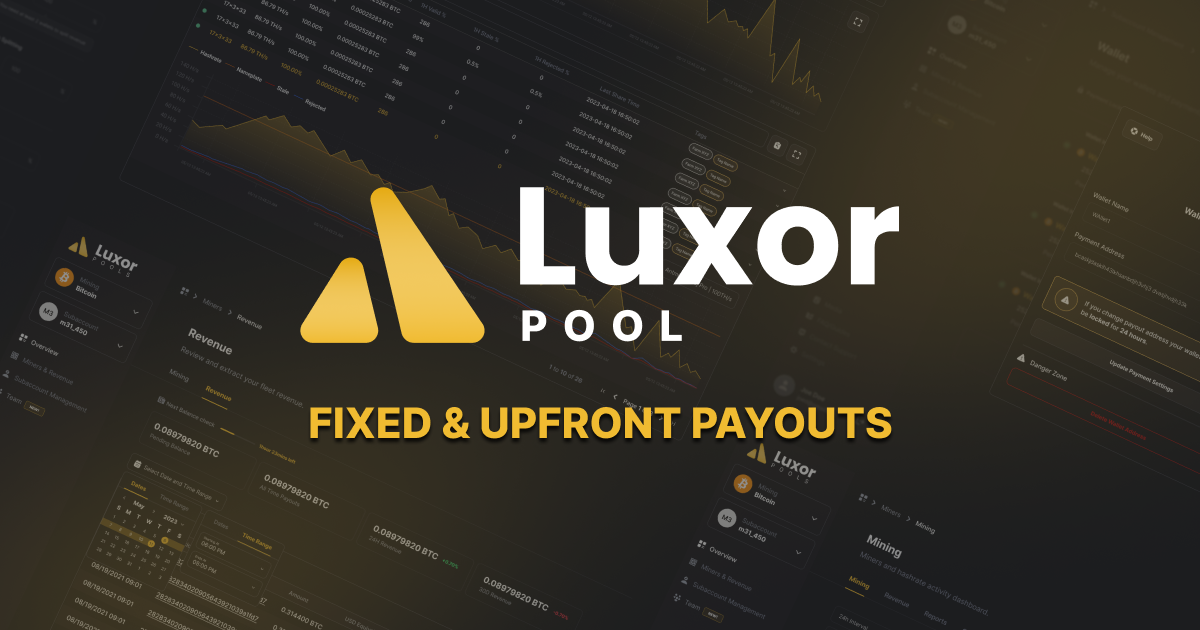
What is Bitcoin Mining Firmware?
Bitcoin mining firmware is often overlooked, but it's a vital component of any bitcoin mining stack.
Firmware is one of the most neglected areas of mining. Historically it has been left for only the technicians in mining facilities to deal with. But with an industry that is rapidly evolving, every piece of the mining stack must be understood and leveraged, so we put together this guide to give a brief overview.
In this guide we cover the following:
- History of Firmware
- Cost-Benefit Analysis of Firmware
- When to Overclock vs Underclock
- Additional Firmware Features
- Other Considerations of Custom Firmware
- Review of Existing Products on the Market
History of Firmware
In 2011, CK announced the launch of CGMiner, an open-source ASIC miner written in C. CGMiner quickly became the industry standard in mining. The open-source code was taken by the ASIC manufacturers and modified to develop their own firmware.
Since that point, CGMiner has become outdated as not a lot of new development has been made on it. Companies like Vnish and ASICseer built on top of it to create new custom firmware for ASICs.
In 2018, Braiins launched Braiins OS as a fully open-source firmware written from scratch in the Rust language, the first alternative to CGMiner based products. At this time they also verified overt AsicBoost on Antminer S9s in 2018, enabling miners to improve their efficiency by 13%. This firmware provided a transparent alternative to the factory firmware. I recommend reading Braiin’s blog post for more back story on their firmware.
In 2020 there was some drama in the firmware industry as some miners threatened some ASIC manufacturers and firmware developers with GPL violations for using CGMiner’s open-source code for-profit.
As of Aug-2020 there hasn’t been a large penetration of custom firmware. We estimate that less than 10EH (8% of the network) is using custom firmware from players like Braiins OS+, Vnish, ASICSeer & MSK. Historically miners have distrusted custom firmware given that there were few credible companies offering it with an SLA that had recourse in the case something went wrong. This is especially true in China, where there is a low penetration of custom firmware.
When to Overclock vs Underclock
Two of the most popular features of custom firmware is the ability to overclock and underclock an ASIC.
Both options are good depending on the situation of the miner. Generally if a miner has a fixed electricity costs they want to overlock them, especially if they have cheap energy to get the maximum hashrate as possible (Th/s). You may still get efficiency gains depending on the firmware but definitely not as much as underclocking.
Underclocking on the other hand is primarily focused on increasing profit margins (vs driving top-line revenue). By underclocking and chip tuning miners can squeeze out extra efficiency of their miners. When an ASIC is close to break-even, such as the majority of S9s it makes sense to underclock them to make them more profitable. If you underclock an S9 the efficiency gain can be more than 20% in some cases.
Cost-Benefit Analysis of Firmware
Due to differences in facilities’ physical environment such as temperature, humidity, and heat dissipation conditions, the actual performance of firmware varies per miner. In addition, even the same model of ASIC under the same batch may have a different physique, so there is no uniform applicable overclock standards. This is the silicon lottery. Performance of custom firmware depends on chip/hashboard quality.
However, with testing over multiple machines, you can get pretty close to accurate results.
For the majority of firmware’s / rigs the cost-benefit analysis is quite easy to do. For example below is the operating performance of ASIC.to a spin-off of Vnish firmware. When used to underclock an S9 you can get a significant boost in efficiency without giving up hashrate. So revenue is equal (or up) and costs are down. You then need to factor in the firmware dev fee which is usually in the range of 2-3% of total mined reward.
For other ASICs / firmware that lowers the hashrate of the rig, the cost-benefit analysis needs to be looked at more holistically. Things such as how much excess capacity you have, if you have capex to fill it etc should be considered.
Additional Firmware Features
Beyond underclocking and overclocking custom firmware also comes with a multitude of other benefits. Some of the more prominent benefits include:
- ASICboost compatibility
- Autotuning: auto tuning frequency to get better efficiency
- Full-farm Deployment: ability to send out the configuration files to an unlimited number of miners on the same network, with no reboot required
- Stability: Automated voltage tuning for hashboard stability and performance
- Immersion-ready/Fan Disable: support for liquid immersion cooling by disabling the fans
- Power monitoring: built-in wattmeter function
- Lower Thermal Threshold: lowers default overheat protection to extend machine life
- Asic Virus Scanner: tool that checks pre-owned ASICs for night switcher and other variants
Other Considerations of Custom Firmware
Underclocking does not have as much risk to it as overclocking does. Overclocking is risky and is known to cause damage to machines. It is also a personal act which means that any damages are not covered under the ASIC warranty.
I talked to Marc from ASIC.to about this and he told me that for the most part Bitmain S9s rarely have problems. The worst he saw was a client with around 1,000 T17s (poorly designed machines), of which 4-5% had issues, although some issues were small. The client was also overclocking by 20% so it was an example of the worst case.
In addition, some Bitmain dashboards have defective hashboards, and it’s hard to tell they are until the firmware is running.
Review of Existing Products on the Market
Almost all firmware increases the chances of machine failure. In some cases this could be in the double digits. So make sure to do your own research into each of the below, do some testing and make a risk-reward decision for using it.
LuxOS is Luxor Technologies custom firmware. Built from scratch in Rust, LuxOS was released in 2022.
LuxOS comes with over 45 API commands to give miners greater control overtheir operations. The custom firmware comes with features like hashrate splitting, over and under clocking, custom scripts for demand responses, remote ASIC tuning, and more.
Braiins is the parent company of Slush Pool the first-ever mining pool. They have been operating in the space for just over a decade now.
Braiins OS+ is unique in that it provides open-source alternatives for every hardware model supported under Braiins OS. While a significant portion of the codebase is identical, Braiins OS+ includes per-chip tuning algorithms which increases the efficiency of ASICs. Braiins also includes its own miner software in the operating system which they built from the ground up in the form of BOSminer. It’s modular code base allows developers to easily customize the software for their own needs while offering several key improvements to CGminer, including support for their open-source mining protocol Stratum V2.
Right now they have support for Bitmain S9s, S17s, and S19s (2% dev fee). Overall Braiins is a great actor in the space and have built a lot of cool things for the mining community so definitely recommend checking them out.
Vnish is a developer from Eastern Europe that has made a name for himself in the firmware space by delivering strong products across ASIC models. Almost any firmware that you may come across that is not on the list is probably a white-label of Vnish’s firmware. Even within North America there are dozen of firmware companies that operate off of his. Vnish’s firmware also comes with a free ASIC management software called Anthill
One of the whitelabels is ASIC.to, run by Marc. Marc provides great customer support and help onboarding. Marc has support for the Antminer S17+, T17+, S17, T17, and S9 for a 2.8% dev fee.
ASICseer created by Alex Levin is another popular firmware for miners. I haven’t personally used this firmware but have heard it has good performance and is quite easy to use. He runs it for the Bitmain S9 and T9 for a 2-3% dev fee. The downside is that you have to deal with Alex who is known for being quite rude and abrasive.
MSKMiner is another firmware provider out of Eastern Europe. They currently support all the S17 (3% fee) models, S9s (1.3-2% fee), T17, T9 (1.8% fee) and L3s (1.8% fee). While not extremely popular in North America yet they do have a partnership with Hive OS. There are rumors that MSK was allegedly spreading virus in their firmware, I haven't confirmed this so please do your own due diligence.
Hashrate Index Newsletter
Join the newsletter to receive the latest updates in your inbox.






